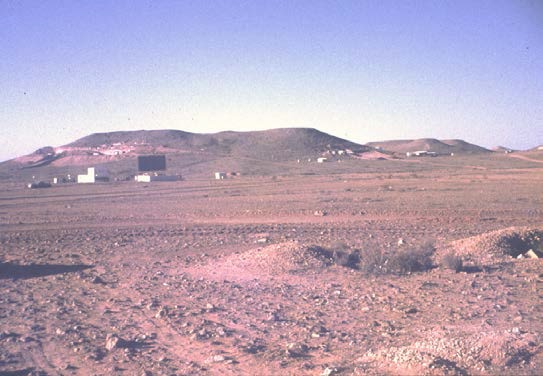History of the Coober Pedy Drive-In

By Sue Britt
Along with opals, underground dugout living and unique mining machinery, the Drive–in is a feature of Coober Pedy. It is one of the last surviving drive-ins in Australia and one of the longest running outdoor theatres in the state. Before the drive-in was built in 1965, the only regular gathering point for people to meet and greet was at the store on truck day. Films had been shown previously in the town hall using projectors mounted on a platform hung from the rafters. Before that there had been showings of cartoons projected on the wall of Brewster’s Store. The Drive-In provided a multicultural venue for people to regularly get together to share news, gossip and entertainment. Families used to come when the gates opened prepared to have a picnic meal before the films started. Opal miners came in their work utes, initially with gelignite among their other daily mining tools. As beer drinking was allowed, the operators decided it would be prudent to ban explosives. The Progress and Miners Association built the Drive-in with money raised from donations and the raffle of a new Holden ute. Volunteer labour did the construction work. The original projection room was a two-storey corrugated iron shed with the two Tokiwa projectors up top and a canteen below.
Along with opals, underground dugout living and unique mining machinery, the Drive–in is a feature of Coober Pedy. It is one of the last surviving drive-ins in Australia and one of the longest running outdoor theatres in the state. Before the drive-in was built in 1965, the only regular gathering point for people to meet and greet was at the store on truck day. Films had been shown previously in the town hall using projectors mounted on a platform hung from the rafters. Before that there had been showings of cartoons projected on the wall of Brewster’s Store. The Drive-In provided a multicultural venue for people to regularly get together to share news, gossip and entertainment. Families used to come when the gates opened prepared to have a picnic meal before the films started. Opal miners came in their work utes, initially with gelignite among their other daily mining tools. As beer drinking was allowed, the operators decided it would be prudent to ban explosives. The Progress and Miners Association built the Drive-in with money raised from donations and the raffle of a new Holden ute. Volunteer labour did the construction work. The original projection room was a two-storey corrugated iron shed with the two Tokiwa projectors up top and a canteen below.
|
The monies raised from the films showings were a
major source of revenue for the town. In 1969 the Drive-In was upgraded. The old cone speakers, mounted on the projection booth, were replaced with the classic drive-in speakers that could be hung on the car window. In its heyday, 8 different films were shown each week, giving Coober Pedy the highest rate of film turnover in Australia. Television arrived in 1980 and with it came the end of the Drive In’s monopoly on cinematic entertainment. It was closed down in 1984 except for occasional special screenings. In 1986, 500 vehicles packed in to see Crocodile Dundee. But, by 1995 the drive-in was nearly derelict, the screen a favourite nesting place for pigeons. |
|
In 1996, a private group approached the District Council with a proposal to re-open the drive-in on a commercial basis. They acquired two Kalee 21 projectors from the Port Augusta Drive-in when it closed down, repaired the screen, restored the canteen and showed movies every week. After 2000, when their lease ran out, a group of volunteers took over, showing films fortnightly.
In 2013, digitisation means that movies on 35mm film will no longer be available. Thus, the Coober Pedy Drive-in must raise $120,000 to go digital in order to continues its valuable community service, preserving an icon of Western culture for locals and tourists. |





